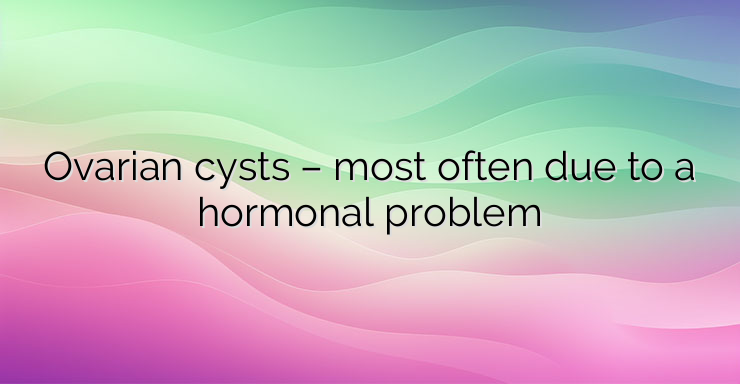An ovarian cyst is a sac filled with fluid or semi-solid material that forms on the ovary. There are different types of ovarian cysts, most of which are painless and harmless (benign). Ovarian cysts usually do not cause symptoms. Rarely, ovarian cysts can cause complications. Most ovarian cysts are functional. They are formed in response to changes in the body during the menstrual cycle. Less commonly, ovarian cysts form for reasons unrelated to menstruation. Functional cysts are the most common type of ovarian cyst and are not associated with a specific disease. They appear as a result of ovulation. These cysts can be a sign that the ovaries are functioning normally. Functional cysts usually shrink over time, usually within 60 days, without specific treatment. A small sac in the ovary called a follicle releases an egg each month as part of the menstrual cycle. A follicular cyst forms when the follicle does not release an egg. Instead, the follicle fills with fluid and becomes larger. After the follicle releases an egg, it forms a group of hormone-producing cells called the corpus luteum. The cyst forms when fluid collects in the corpus luteum, causing it to grow. Not all ovarian cysts form in response to the menstrual cycle. They are not always signs of illness. Such cysts include: Cystadenomas. These cysts form on the surface of the ovary. They may be filled with fluid that is watery or mucus-like. Dermoid cysts (teratomas). Dermoid cysts consist of cells that make up all types of tissue in the human body, ranging from skin, hair, teeth, and even brain tissue. Endometriomas. These cysts are filled with endometrial tissue. Ovarian cancer. Unlike the above conditions, tumors are solid masses of cancer cells. The risks of developing cysts increase based on: Age. Ovarian cysts are more common before menopause. Pregnancy. Cysts are more likely to form and persist during pregnancy. Diseases such as endometriosis, hormonal problems increase the risks of developing ovarian cysts. Ovulation is a leading cause of ovarian cysts. Other causes include: Abnormal cell reproduction. Atypical cell proliferation can lead to the formation of cysts such as dermoids and cystadenomas. Endometriosis. These cysts often form on the ovary in the advanced stages of endometriosis. Pelvic inflammatory disease. Severe pelvic infections can spread to the ovaries, causing cysts. Some smaller cysts cause no symptoms. In these cases, women don’t even realize they have a cyst. Larger cysts may be characterized by: Pelvic pain or dull back pain. A feeling of fullness (bloating) located in the lower abdomen,which may be felt more pronounced on one side of the body. Pain during intercourse (dyspareunia). Painful menstruation. Symptoms that persist for a longer time may indicate a condition called polycystic ovary syndrome. This condition is characterized by irregular menstrual periods and other hormone-related problems, including obesity and infertility. Other symptoms of PCOS include hirsutism (increased body hair growth) and difficulty losing weight. What are the complications of an ovarian cyst? Ovarian cysts that develop after menopause are more likely to be cancerous than cysts that form before menopause. Functional cysts often rupture without causing negative symptoms. But sometimes a ruptured cyst can cause severe pain and swelling in the abdomen. The larger a cyst, the greater the risk of rupture. The cysts can become so large that they change the shape of the ovary, increasing the likelihood that it will rotate on its axis. The twisting can prevent blood flow to the ovary, causing it to die. Severe pain, nausea and vomiting are signs of ovarian torsion. References: 1. American College of Obstetricians and Gynecologists’ Committee on Practice Bulletins—Gynecology. Practice bulletin no. 174: evaluation and management of adnexal masses. (https://pubmed.ncbi.nlm.nih.gov/27776072/)Obstet Gynecol. 2. Farghaly SA. Current diagnosis and management of ovarian cysts. (https://pubmed.ncbi.nlm.nih.gov/25551948/) Clin Exp Obstet Gynecol. 3. Smith-Bindman R, Poder L, Johnson E, et al. Risk of malignant ovarian cancer based on ultrasonography findings in a large unselected population. (https://pubmed.ncbi.nlm.nih.gov/30419104/)nausea and vomiting are signs of ovarian torsion. References: 1. American College of Obstetricians and Gynecologists’ Committee on Practice Bulletins—Gynecology. Practice bulletin no. 174: evaluation and management of adnexal masses. (https://pubmed.ncbi.nlm.nih.gov/27776072/)Obstet Gynecol. 2. Farghaly SA. Current diagnosis and management of ovarian cysts. (https://pubmed.ncbi.nlm.nih.gov/25551948/) Clin Exp Obstet Gynecol. 3. Smith-Bindman R, Poder L, Johnson E, et al. Risk of malignant ovarian cancer based on ultrasonography findings in a large unselected population. (https://pubmed.ncbi.nlm.nih.gov/30419104/)nausea and vomiting are signs of ovarian torsion. References: 1. American College of Obstetricians and Gynecologists’ Committee on Practice Bulletins—Gynecology. Practice bulletin no. 174: evaluation and management of adnexal masses. (https://pubmed.ncbi.nlm.nih.gov/27776072/)Obstet Gynecol. 2. Farghaly SA. Current diagnosis and management of ovarian cysts. (https://pubmed.ncbi.nlm.nih.gov/25551948/) Clin Exp Obstet Gynecol. 3. Smith-Bindman R, Poder L, Johnson E, et al. Risk of malignant ovarian cancer based on ultrasonography findings in a large unselected population. (https://pubmed.ncbi.nlm.nih.gov/30419104/)


Leave a Reply